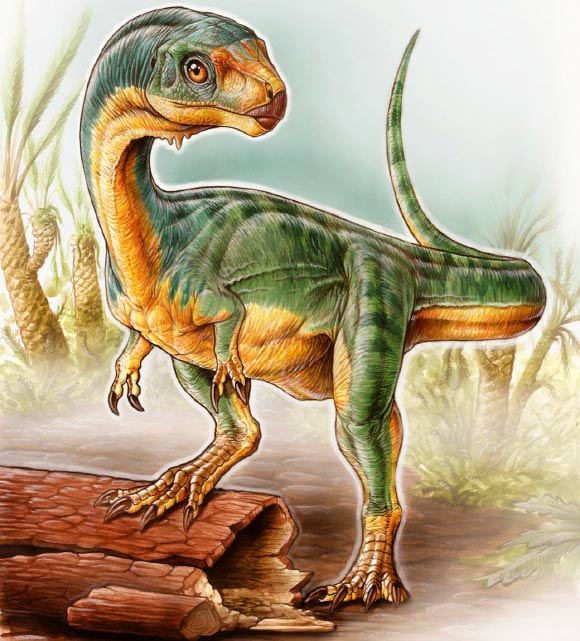Chilesaurus diegosuarezi, a peculiar dinosaur that roamed the Earth some 145 million years ago and looked like a raptor but was in fact a plant-eater, fills in a large gap between herbivorous dinosaurs and theropods, the group that includes Tyrannosaurus rex.

Chilesaurus diegosuarezi was up to 3 meters long; the different parts of its body were adapted to a particular diet and way of life, which was similar to other groups of dinosaurs. Image credit: Gabriel Lio.
Chilesaurus diegosuarezi was first described in 2015 by Dr. Fernando Novas of the Bernardino Rivadavia Natural Sciences Museum in Buenos Aires, Argentina, and co-authors.
The prehistoric creature lived in what is now Chile during the Upper Jurassic epoch and possessed a bizarre suite of anatomical features. For example, its head resembles that of a carnivore, but it has flat teeth for grinding up plant matter.
Professor Paul Barrett of the Natural History Museum London and Matthew Baron of the University of Cambridge have now analyzed more than 450 anatomical characteristics of early dinosaurs and correctly placed Chilesaurus diegosuarezi in the dinosaur family tree.
“Chilesaurus diegosuarezi almost looks like it was stitched together from different animals, which is why it baffled everybody,” Baron said.
Earlier research suggested that this dinosaur belonging to Tetanurae, a taxonomically and ecologically diverse group of theropod dinosaurs, but the new study suggests that it was probably a very early member of a completely different group: Ornithischia, the ‘bird-hipped’ group of dinosaurs that includes Stegosaurus, Triceratops and Iguanodon.
“Chilesaurus diegosuarezi is one of the most puzzling and intriguing dinosaurs ever discovered,” Professor Barrett said.
“Its weird mix of features places it in a key position in dinosaur evolution and helps to show how some of the really big splits between the major groups might have come about.”
“The bird-hipped dinosaurs have several common physical traits: the two most notable of these are an inverted, bird-like hip structure and a beak-like structure for eating,” the paleontologists explained.
“The inverted hips allowed for bigger, more complex digestive systems, which in turn allowed larger plant-eaters to evolve.”
“While Chilesaurus diegosuarezi has a bird-like hip structure, and has flat teeth for grinding up plants, it does not possess the distinctive ‘beak’ of many other bird-hipped dinosaurs, which is what makes it such an important find.”
“Before this, there were no transitional specimens — we didn’t know what order these characteristics evolved in,” Baron said.
“This shows that in bird-hipped dinosaurs, the gut evolved first, and the jaws evolved later — it fills the gap quite nicely.”
“There was a split in the dinosaur family tree, and the two branches took different evolutionary directions,” he added.
“This seems to have happened because of change in diet for Chilesaurus diegosuarezi.”
“It seems it became more advantageous for some of the meat eating dinosaurs to start eating plants, possibly even out of necessity.”
The research appears today in the journal Biology Letters.
_____
Matthew G. Baron & Paul M. Barrett. A dinosaur missing-link? Chilesaurus and the early evolution of ornithischian dinosaurs. Biology Letters, published online August 15, 2017; doi: 10.1098/rsbl.2017.0220







